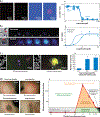Conceptual and Experimental Tools to Understand Spatial Effects and Transport Phenomena in Nonlinear Biochemical Networks Illustrated with Patchy Switching
- PMID: 28654324
- PMCID: PMC10852032
- DOI: 10.1146/annurev-biochem-060815-014207
Conceptual and Experimental Tools to Understand Spatial Effects and Transport Phenomena in Nonlinear Biochemical Networks Illustrated with Patchy Switching
Abstract
Many biochemical systems are spatially heterogeneous and exhibit nonlinear behaviors, such as state switching in response to small changes in the local concentration of diffusible molecules. Systems as varied as blood clotting, intracellular calcium signaling, and tissue inflammation are all heavily influenced by the balance of rates of reaction and mass transport phenomena including flow and diffusion. Transport of signaling molecules is also affected by geometry and chemoselective confinement via matrix binding. In this review, we use a phenomenon referred to as patchy switching to illustrate the interplay of nonlinearities, transport phenomena, and spatial effects. Patchy switching describes a change in the state of a network when the local concentration of a diffusible molecule surpasses a critical threshold. Using patchy switching as an example, we describe conceptual tools from nonlinear dynamics and chemical engineering that make testable predictions and provide a unifying description of the myriad possible experimental observations. We describe experimental microfluidic and biochemical tools emerging to test conceptual predictions by controlling transport phenomena and spatial distribution of diffusible signals, and we highlight the unmet need for in vivo tools.
Keywords: Damköhler number; flow; mass transfer; microfluidics; signaling; state switching.
Figures







Similar articles
-
Using chemistry and microfluidics to understand the spatial dynamics of complex biological networks.Acc Chem Res. 2008 Apr;41(4):549-58. doi: 10.1021/ar700174g. Epub 2008 Jan 25. Acc Chem Res. 2008. PMID: 18217723 Free PMC article.
-
Confinement regulates complex biochemical networks: initiation of blood clotting by "diffusion acting".Biophys J. 2009 Oct 21;97(8):2137-45. doi: 10.1016/j.bpj.2009.08.004. Biophys J. 2009. PMID: 19843446 Free PMC article.
-
Microfluidics-based in vivo mimetic systems for the study of cellular biology.Acc Chem Res. 2014 Apr 15;47(4):1165-73. doi: 10.1021/ar4002608. Epub 2014 Feb 20. Acc Chem Res. 2014. PMID: 24555566 Free PMC article.
-
Nonlinear Phenomena in Microfluidics.Chem Rev. 2022 Apr 13;122(7):6921-6937. doi: 10.1021/acs.chemrev.1c00985. Epub 2022 Feb 23. Chem Rev. 2022. PMID: 35194990 Review.
-
In silico modeling of endocrine organ-on-a-chip systems.Math Biosci. 2022 Oct;352:108900. doi: 10.1016/j.mbs.2022.108900. Epub 2022 Sep 6. Math Biosci. 2022. PMID: 36075288 Review.
Cited by
-
Acute Lymph Node Slices Are a Functional Model System to Study Immunity Ex Vivo.ACS Pharmacol Transl Sci. 2021 Jan 8;4(1):128-142. doi: 10.1021/acsptsci.0c00143. eCollection 2021 Feb 12. ACS Pharmacol Transl Sci. 2021. PMID: 33615167 Free PMC article.
-
Spatially Resolved Analytical Chemistry in Intact, Living Tissues.Anal Chem. 2020 Dec 1;92(23):15255-15262. doi: 10.1021/acs.analchem.0c03625. Epub 2020 Nov 17. Anal Chem. 2020. PMID: 33201681 Free PMC article. Review.
-
Modeling Immunity In Vitro: Slices, Chips, and Engineered Tissues.Annu Rev Biomed Eng. 2021 Jul 13;23:461-491. doi: 10.1146/annurev-bioeng-082420-124920. Epub 2021 Apr 19. Annu Rev Biomed Eng. 2021. PMID: 33872520 Free PMC article.
-
User-defined local stimulation of live tissue through a movable microfluidic port.Lab Chip. 2018 Jul 10;18(14):2003-2012. doi: 10.1039/c8lc00204e. Lab Chip. 2018. PMID: 29904762 Free PMC article.
-
Towards spatially-organized organs-on-chip: Photopatterning cell-laden thiol-ene and methacryloyl hydrogels in a microfluidic device.Organs Chip. 2022 Dec;4:100018. doi: 10.1016/j.ooc.2022.100018. Epub 2022 Jan 26. Organs Chip. 2022. PMID: 35535262 Free PMC article.
References
-
- Tayalia P, Mooney DJ. 2009. Controlled growth factor delivery for tissue engineering. Adv. Mater 21:3269–85 - PubMed
-
- Ehrbar M, Zeisberger SM, Raeber GP, Hubbell JA, Schnell C, Zisch AH. 2008. The role of actively released fibrin-conjugated VEGF for VEGF receptor 2 gene activation and the enhancement of angiogenesis. Biomaterials 29:1720–29 - PubMed
-
- Martino MM, Hubbell JA. 2010. The 12th-14th type III repeats of fibronectin function as a highly promiscuous growth factor-binding domain. FASEB J. 24:4711–21 - PubMed
-
- Dowd CJ, Cooney CL, Nugent MA. 1999. Heparan sulfate mediates bFGF transport through basement membrane by diffusion with rapid reversible binding. J. Biol. Chem 274:5236–44 - PubMed
Publication types
MeSH terms
Grants and funding
LinkOut - more resources
Full Text Sources
Other Literature Sources
Medical

